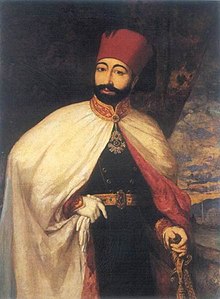Our website is made possible by displaying online advertisements to our visitors.
Please consider supporting us by disabling your ad blocker.
Mahmud II
| Mahmud II | |||||
|---|---|---|---|---|---|
| Ottoman Caliph Amir al-Mu'minin Custodian of the Two Holy Mosques Sultan of the two lands, Khan of the two seas[1] | |||||
 1830 portrait | |||||
| Sultan of the Ottoman Empire (Padishah) | |||||
| Reign | 28 July 1808 – 1 July 1839 | ||||
| Predecessor | Mustafa IV | ||||
| Successor | Abdulmejid I | ||||
| Born | 20 July 1785 Topkapı Palace, Constantinople, Ottoman Empire | ||||
| Died | 1 July 1839 (aged 53) Constantinople, Ottoman Empire | ||||
| Burial | Tomb of Sultan Mahmud II, Fatih, Istanbul, Turkey | ||||
| Consorts | |||||
| Issue Among others | |||||
| |||||
| Dynasty | Ottoman | ||||
| Father | Abdul Hamid I | ||||
| Mother | Nakşidil Sultan | ||||
| Religion | Sunni Islam | ||||
| Tughra |  | ||||
Mahmud II (Ottoman Turkish: محمود ثانى, romanized: Maḥmûd-u s̠ânî, Turkish: II. Mahmud; 20 July 1785 – 1 July 1839) was the sultan of the Ottoman Empire from 1808 until his death in 1839. Often described as the "Peter the Great of Turkey",[2] Mahmud instituted extensive administrative, military, and fiscal reforms. His disbandment of the conservative Janissary corps removed a major obstacle to his and his successors' reforms in the Empire. Mahmud's reign was also marked by further Ottoman military defeat and loss of territory as a result of nationalist uprisings and European intervention.
Mahmud ascended the throne following an 1808 coup which deposed his half-brother Mustafa IV. Early in his reign, the Ottoman Empire ceded Bessarabia to Russia at the end of the 1806–1812 Russo-Turkish War. Greece waged a successful war of independence that started in 1821 with British, French and Russian support, and Mahmud was forced to recognize the independent Greek state in 1832. The Ottomans lost more territory to Russia after the Russo-Turkish War of 1828–1829, and Ottoman Algeria was conquered by France beginning in 1830. Despite these setbacks, with a new modern army, Sultan Mahmud initiated a campaign of recentralization in the empire which saw the submission of derebeys and Ayans to central authority.
The Empire's continued decline convinced Mahmud to resume the reforms that were halted before he came to power. In 1826, he orchestrated the Auspicious Incident, in which the Kapıkulu were forcibly abolished and many of its members executed, paving the way for the establishment of a modern Ottoman army and further military reforms. Mahmud also made sweeping changes to the bureaucracy in order to reestablish royal authority and increase administrative efficiency, and oversaw a reorganisation of the Ottoman foreign office. In 1838, Mahmud established the Supreme Council of Judicial Ordinances, and the next year, he introduced a Council of Ministers. He died of tuberculosis later that year and was succeeded by his son Abdulmejid I, who would continue to implement his modernization efforts.
- ^ "Beshlik - Mahmud II Second Issue".
- ^ Eugene Rogan (4 October 2002). Outside In: Marginality in the Modern Middle East. I.B.Tauris. p. 15. ISBN 978-1-86064-698-0.
Previous Page Next Page


